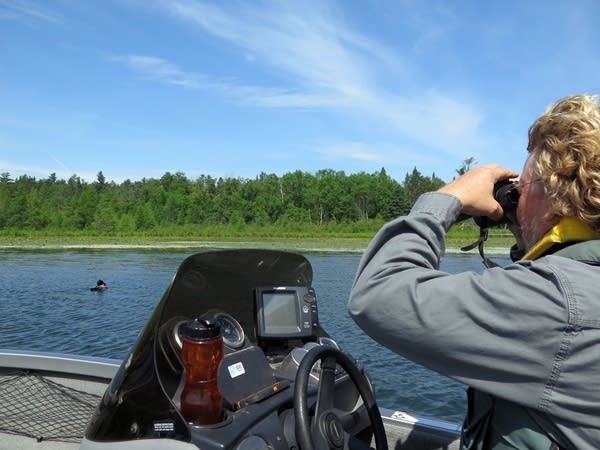Minn. loons could get aid from BP oil spill cleanup funds

Go Deeper.
Create an account or log in to save stories.
Like this?
Thanks for liking this story! We have added it to a list of your favorite stories.
Kevin Woizeschke peered through binoculars at a pair of loons gliding across the water.
Woizeschke, a nongame wildlife biologist for the Minnesota Department of Natural Resources, was in a boat on West Fox Lake about 30 miles north of Brainerd, Minn. He was looking for loons wearing a silver leg band that holds a tiny geolocator tag.
"These geotags are $700 each," Woizeschke said. "The information that is on them is even way more valuable than that."
That information includes estimates of the bird's location and how deep it's been diving. For scientists trying to learn more about where loons are spending their time, that knowledge is priceless.
Turn Up Your Support
MPR News helps you turn down the noise and build shared understanding. Turn up your support for this public resource and keep trusted journalism accessible to all.

Researchers have been trying to figure out whether Minnesota's beloved loons were affected by the BP oil spill seven years ago in the Gulf of Mexico. They think they've established the connection.
Now they're seeking federal money to help restore the damage to the state's loon population, estimated at about 12,000 birds — the most of any U.S. state except Alaska.
Carrol Henderson, the DNR's nongame program wildlife supervisor, has led the DNR's loon research since the 2010 Deepwater Horizon disaster.
"Over the last seven years, we've kind of put all the pieces together to correlate the status of Minnesota's loons, their behavior their migration their feeding activities to the places that were most affected by the oil spill," Henderson said.

After loons hatch, they fly south and don't return to Minnesota until they're 3 years old. So scientists knew there was a good chance young Minnesota loons were in the gulf in April 2010 when the BP spill dumped nearly 5 million barrels of oil.
But they wanted to know if the loons were going to the most heavily polluted areas. So, they captured dozens of loons and implanted or banded them with tracking devices.
They also took samples of the birds' blood, fat and feathers to test for contaminants, either from the petroleum itself or from the chemical used to disperse the oil in the gulf.
"We found out that they're diving all the way to the bottom where the oil would have settled," Henderson said. "They're picking it up, it's in their feathers. It's in their blood. It's in their eggs the following spring. They're bringing this back to Minnesota."
Researchers don't yet know whether the contaminants will affect the loons' life span or reproduction. Loons don't mate until they're 5 years old, so some of the affected birds are just starting to have chicks.

But now that the research has confirmed that Minnesota's loons were directly impacted by the oil spill, scientists want to start working to restore the damage.
Henderson hopes to hear any day whether the U.S. Fish and Wildlife Service will grant Minnesota $6 million from the BP settlement for the first phase of a 15-year loon remediation plan. If that's successful, additional money could follow.
"We have more loons than any other state in the lower 48 states, and we like to keep it that way," he said.
Some of the funds would be used to restore shoreline habitat on loon nesting lakes and protect deep, cold lakes that support fatty fish called cisco that loons eat before migrating south.

Money would also go to promotion of non-toxic fishing tackle, since lead poisoning is one of the biggest causes of loon mortality.
The DNR also wants to partner with lake associations to create a loon-friendly designation for lakes, Henderson said.
That's good news for loon lovers like Jim Sand, who lives on Big Fish Lake near Cold Spring. Sand is a longtime volunteer with the Minnesota Loon Watcher program, which helps keep tabs on the number of loons throughout the state.
Sand and other lakeshore owners usually put out three nesting platforms every year on Big Fish Lake. This year, the lake association raised $2,000 in donations for a fourth platform, plus devices to keep boats away. It's the type of project that could benefit from the federal funding.
Henderson said it will be important to track the success of the restoration program to demonstrate to federal officials that it is actually increasing the loon population.
"We want to make sure that in Minnesota, it does make a difference," he said.


